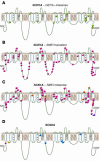Sodium channel mutations in epilepsy and other neurological disorders
- PMID: 16075041
- PMCID: PMC1180547
- DOI: 10.1172/JCI25466
Sodium channel mutations in epilepsy and other neurological disorders
Abstract
Since the first mutations of the neuronal sodium channel SCN1A were identified 5 years ago, more than 150 mutations have been described in patients with epilepsy. Many are sporadic mutations and cause loss of function, which demonstrates haploinsufficiency of SCN1A. Mutations resulting in persistent sodium current are also common. Coding variants of SCN2A, SCN8A, and SCN9A have also been identified in patients with seizures, ataxia, and sensitivity to pain, respectively. The rapid pace of discoveries suggests that sodium channel mutations are significant factors in the etiology of neurological disease and may contribute to psychiatric disorders as well.
Figures




Similar articles
-
The voltage-gated sodium channel Scn8a is a genetic modifier of severe myoclonic epilepsy of infancy.Hum Mol Genet. 2007 Dec 1;16(23):2892-9. doi: 10.1093/hmg/ddm248. Epub 2007 Sep 19. Hum Mol Genet. 2007. PMID: 17881658
-
Sodium channel gene family: epilepsy mutations, gene interactions and modifier effects.J Physiol. 2010 Jun 1;588(Pt 11):1841-8. doi: 10.1113/jphysiol.2010.188482. Epub 2010 Mar 29. J Physiol. 2010. PMID: 20351042 Free PMC article. Review.
-
Sodium channels and neurological disease: insights from Scn8a mutations in the mouse.Neuroscientist. 2001 Apr;7(2):136-45. doi: 10.1177/107385840100700208. Neuroscientist. 2001. PMID: 11496924 Review.
-
Disruption of the SCN2A and SCN3A genes in a patient with mental retardation, neurobehavioral and psychiatric abnormalities, and a history of infantile seizures.Clin Genet. 2011 Aug;80(2):191-5. doi: 10.1111/j.1399-0004.2010.01526.x. Epub 2010 Aug 2. Clin Genet. 2011. PMID: 20807223
-
SCN1A mutations and epilepsy.Hum Mutat. 2005 Jun;25(6):535-42. doi: 10.1002/humu.20178. Hum Mutat. 2005. PMID: 15880351 Review.
Cited by
-
Epilepsy and sudden unexpected death in epilepsy in a mouse model of human SCN1B-linked developmental and epileptic encephalopathy.Brain Commun. 2023 Oct 20;5(6):fcad283. doi: 10.1093/braincomms/fcad283. eCollection 2023. Brain Commun. 2023. PMID: 38425576 Free PMC article.
-
Identification and In-Silico study of non-synonymous functional SNPs in the human SCN9A gene.PLoS One. 2024 Feb 23;19(2):e0297367. doi: 10.1371/journal.pone.0297367. eCollection 2024. PLoS One. 2024. PMID: 38394191 Free PMC article.
-
Casein Kinase 2 Affects Epilepsy by Regulating Ion Channels: A Potential Mechanism.CNS Neurol Disord Drug Targets. 2024;23(7):894-905. doi: 10.2174/1871527322666230622124618. CNS Neurol Disord Drug Targets. 2024. PMID: 37350003 Review.
-
Neurodevelopmental disorders: 2023 update.Free Neuropathol. 2023 May 8;4:4-8. doi: 10.17879/freeneuropathology-2023-4701. eCollection 2023 Jan. Free Neuropathol. 2023. PMID: 37347033 Free PMC article.
-
Trichloroethanol, an active metabolite of chloral hydrate, modulates tetrodotoxin-resistant Na+ channels in rat nociceptive neurons.BMC Anesthesiol. 2023 Apr 29;23(1):145. doi: 10.1186/s12871-023-02105-0. BMC Anesthesiol. 2023. PMID: 37120567 Free PMC article.
References
-
- Jiang Y, et al. X-ray structure of a voltage-dependent K+ channel. Nature. 2003;423:33–41. - PubMed
-
- Jiang Y, Ruta V, Chen J, Lee A, MacKinnon R. The principle of gating charge movement in a voltage-dependent K+ channel. Nature. 2003;423:42–48. - PubMed
-
- Isom LL, De Jongh KS, Catterall WA. Auxiliary subunits of voltage-gated ion channels. Neuron. 1994;12:1183–1194. - PubMed
-
- Plummer NW, Meisler MH. Evolution and diversity of mammalian sodium channel genes. Genomics. 1999;57:323–331. - PubMed
Publication types
MeSH terms
Substances
Grants and funding
LinkOut - more resources
Full Text Sources
Other Literature Sources
Medical
Molecular Biology Databases


